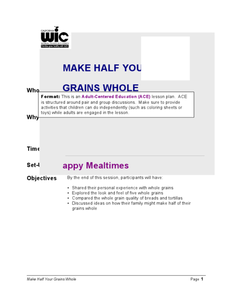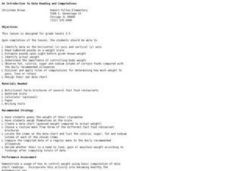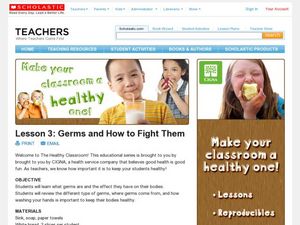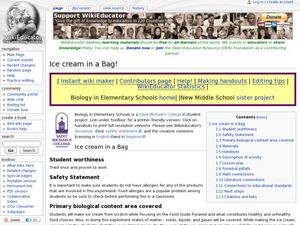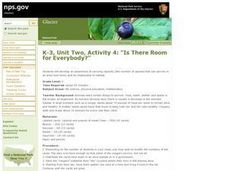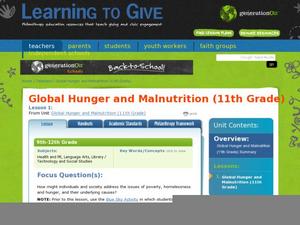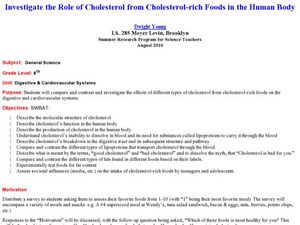Curated OER
Make Half Your Grains Whole
Students discuss the benefits of eating whole grains. In this adult health lesson, students compare samples of whole grain food products. They recommend ways on how to incorporate whole grains in their family diet.
Curated OER
An Introduction to Data Reading and Computations
Students discover data reading and computations. In this math lesson plan, students collect nutritional data about intakes of certain foods compared with daily recommended allowances. Students create their own data charts based on their...
Curated OER
The Energy Equation
Students explore human energy components. In this personal health lesson plan, students determine how food, sleep, and exercise impact human energy levels as they play BAM! Body and Mind interactive games. Students create motivational...
Curated OER
Germs and How to Fight Them
Students learn how important it is to stay healthy. In this germ lesson plan, student learn what germs are and the effect they have on healthy bodies and explore how important it is to keep their bodies healthy through a classroom...
Curated OER
Ice Cream in a Bag!
Students follow a recipe to make ice cream. In this ice cream lesson plan, students make their own ice cream by measuring out ingredients and following directions.
Curated OER
What Is Hunger and Who are the Hungry?
Students investigate the purpose of food and how the body needs it for survival. The social problem of hunger is introduced and then researched looking for its causes and some solutions. There is background information in the lesson for...
Curated OER
Child Care Unit
In this activity, child care apprentices prepare granola bars to serve to preschoolers. A recipe and lab evaluation sheet are included, but the actual procedure is vague. It could be used in a cooking class or as a career exploration...
Curated OER
The Human Organism
Students identify their feelings and learn constructive ways of handling conflict. In this human mental health lesson, students identify their feelings, learn how to tell others about their feelings, and learn how to resolve conflict....
Curated OER
A Funky Healthy Life Style!
Learners name the five food groups and classify foods according to group. They tell how proteins, carbohydrates, vitamins/minerals, and water help their body. Students discuss how play and exercise can help their body.
Curated OER
What's on Your Plate?
Students analyze the calorie content of food. In this health science instructional activity, students discuss how excess calories affect our body. They write a healthy meal plan for their family.
Curated OER
Belonging and Identity
Students participate in a class in which they eat in different social groups. As a class, they discuss the importance of eating a healthy diet and how some foods are harmful to some but not to others. They use the internet to research...
Curated OER
Family Life Cycle - Children's Lab
Students review how their nutritional needs change over time. In groups, they design their own menu in which they get all the nutrients they need. To end the lesson, they share their foods with the class and complete a wordsearch...
Curated OER
Good Enough To Eat
Students are introduced to the five food groups. In groups, they place different foods into the correct section of the Food Pyramid. Using different types of technology, they create one page of a class ABC book sharing what they know...
Curated OER
"Mush Lab"
Students use the information they learned from reading food labels to create mush meals. They blend unlikely meals together to form the mush and then evaluate its nutritional value. They examine their own eating habits after the lab is...
Curated OER
Is There Room for Everybody?
Third graders examine the capacity of animals able to live in one habitat. In this habitat lesson, 3rd graders play a game that shows the food chain and the interactions between animals in an area. Students discover that food is a major...
National Endowment for the Humanities
“Read All About It”: Primary Source Reading in “Chronicling America”
Can investigative journalism become too sensationalistic and accusatory, or is it vital for the survival of a democracy? Middle schoolers analyze primary source documents from early 20th-century newspapers as well as Theodore Roosevelt's...
Curated OER
Global Hunger and Malnutrition
Is there a difference between hunger and malnutrtion? Is this a problem only in third world countries? How does hunger and malnutrition affect the community? Why do these problems exist when the world produces enough food to feed...
Curated OER
Home Living / Daily Living: Personal Hygiene—Use of Napkin
Staying clean is a big part of staying healthy and looking good in the community. Personal hygiene and napkin use are the focus of this activity. Your class will eat a messy food, look in a mirror to see if their face is messy, then...
Curated OER
Stress Management
Stressed? Stressed students? Check out a instructional activity that includes a checklist of causes of stress, suggestions for ways to deal with stress, and a role-play activity. Definitely worth a look.
Curated OER
Nutrition Unit
Students engage in a variety of activities designed to help them understand about the importance of good nutrition and eating healthy foods. The activities include playing food bingo, making a collage, designing posters, etc.
Curated OER
Breakfast First
Students explore reasons why breakfast is an important meal. In this healthy eating lesson, students research the benefits of eating breakfast and create a cookbook of healthy breakfast items. Students establish a breakfast plan for two...
Curated OER
Mater Your Munchies
Students explore the various food groups while doing a physical activity.
Curated OER
Investigate the Role of Cholesterol from Cholesterol-rich Foods in the Human Body
Eighth graders assess fat content of different food samples. In this biology lesson, 8th graders create a flowchart showing the transport of cholesterol in the bloodstream. They perform tests for the presence of lipids on food samples.
Curated OER
Food For Heart Challenge
Students use a variety of locomotor motions to obtain different pictures of foods for thieir teams. They must decide if the food is always healthy.


